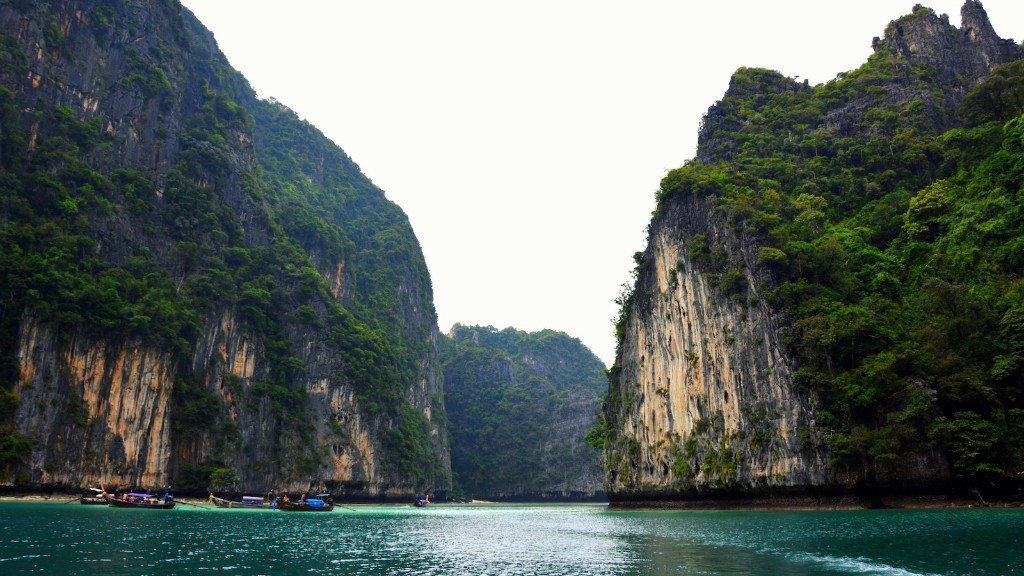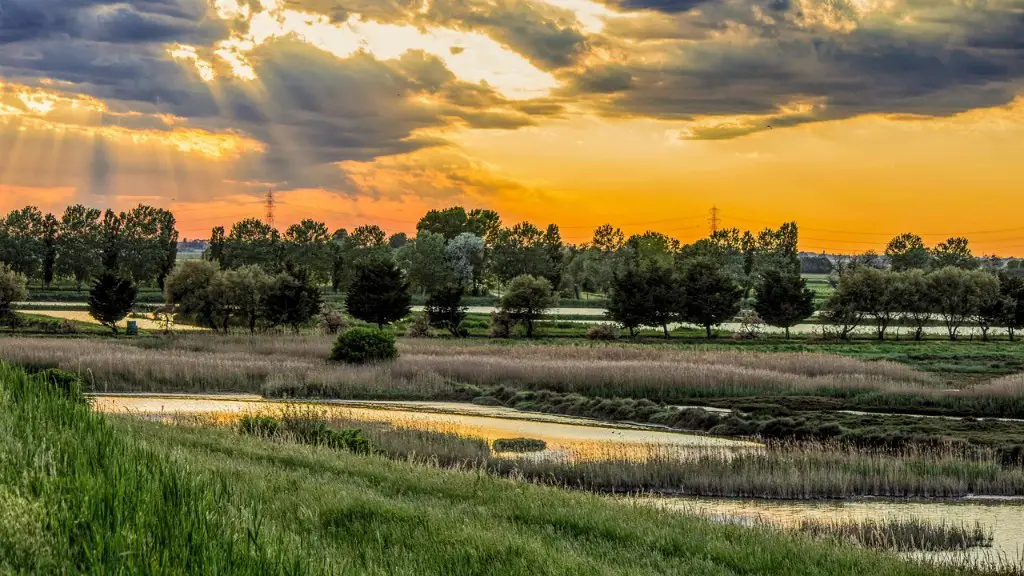The mighty Mississippi River is one of the most significant waterways in North America, running more than 2300 miles in length, draining some of the continent’s largest swaths of land. It rises in northern Minnesota and flows south, through the middle of the United States, ending in the Gulf of Mexico. Although the Mississippi is thought of mostly as a south-flowing river, its direction of flow depends on where you are on the river.
At the headwaters, the Mississippi River is a north-flowing stream, moving slowly toward the Twin Cities of Minneapolis and St. Paul. From these cities, the river turns sharply south and continues that way for the remainder of its journey. South of the headwaters, the river generally flows south, but also has multiple branches that often curve east and west, adding complexity to its path.
The main stem of the Mississippi River is divided into two parts—the Upper Mississippi and the Lower Mississippi. The Upper Mississippi is longer and is comprised of the upper reaches of the river. This area includes some of the largest reservoirs in the United States and the longest unaltered stretch of the river. The Lower Mississippi is shorter and runs from St. Louis, Missouri to the Gulf Coast of Louisiana.
The flow of the Mississippi River is largely dictated by the diverse topography of the land it traverses. The river current is typically slower in meandering bends, and faster and swifter in narrow straight reaches. In the Great River Bend, the river snakes back and forth to traverse the low-lying and wide-open landscapes of Illinois, Iowa, and Missouri. In this stretch, the combination of current and backwaters creates a unique environment as the river’s water flows both north and south.
The flow of the Mississippi River is also influenced by the many tributaries that join it along the way, such as the Ohio River and the Arkansas River. These large tributaries create a tremendous amount of water volume, increasing the speed of the main stem Mississippi near the mouths of the tributary rivers. This results in a very swift current and some of the biggest and most powerful rapids in North America.
The flow of the Mississippi River also depends on heavy rains, floods, and other weather-related incidents. When heavy rain falls, the muddy waters can rise quickly and can cause dangerous flooding conditions. The U.S. Army Corps of Engineers maintains multiple dams and levees along the river to help control this potential flooding. In years of drought and low snowpack, the dams and levees also play a role in ensuring the river has enough water to sustain its various uses.
The currents of the river are also heavily influenced by the courses of human development. The channel of the Mississippi has changed dramatically since the first Europeans settled in North America. Humans have constructed cities and dams, which have altered the flow of the river and its normal course. Despite these changes, the Mississippi River still continues to flow south and has been an integral part of American culture and development in the centuries since.
Economic Impact
The Mississippi River has had an immense economic impact on American history, underpinning much of the nation’s growth and development. As a waterway, it has served as a major transportation route for centuries, as boats, barges, and steamboats sailed its waters. In addition to its utility as a transportation route, the river has been a vital source of food, water, and energy for many communities over the years, and continues to provide these resources for many today.
The Mississippi River supports a number of industries. The river has long been a major source of trade and transportation for goods such as coal, grain, and livestock. It is also an important source of power and energy. Commercial fishing, as well as recreational fishing, also brings in significant revenue along the river. There is also a considerable amount of tourism along its banks, with visitors coming to take in the unique natural beauty of the river and its surroundings.
The Mississippi River’s economic impact is felt in the many cities, towns, and watersheds that are located along its banks. These communities rely on the river for their livelihood, and the river has become an important part of the fabric of their communities. In addition, the river is a major source of employment, providing jobs to those who work in its fishing, transit, and tourism industries.
The Mississippi River also has an important impact on the environment. The diversity of species living in and around the river provides tremendous ecological value. The river serves as an important refuge for animals and plants, providing important habitat for numerous species. The river is also an important source of drinking water, with many of the cities along the river dependent on its waters for their water supply.
Environmental Concerns
The Mississippi River has long been subject to environmental concerns, as the river has become increasingly polluted over the years. Industrialization, agricultural development, and other human activities have led to increased amounts of runoff, and the river has become polluted with toxic chemicals and sediment. The resulting runoff has led to hazardous water quality and decreased the natural habitat diversity along the river banks.
Erosion has also become an increasingly pressing issue along the river. As a result of the channeling and dredging of the river, large portions of the banks and bluffs have been destroyed. This has caused an increase in sediment and other pollutants to enter the river. Erosion has also been exacerbated by man-made levees, dams, and other structures that prevent natural flooding, which is required to maintain the natural sediment balance.
The interruption of the natural flow of the river has had a major impact on the complex system of plants and animals found in the river’s habitats. Not only has the artificial channeling caused a decrease in the variety of species, but it has also put immense pressure on existing species that depend on a system of undisturbed habitats, such as the endangered pallid sturgeon.
Pollution of the Mississippi River has also had a major impact on the health of humans. Pollutants, such as heavy metals and nitrogen runoff, have entered the water and have contaminated drinking water sources downstream. Additionally, the interrupted flow and massive levees have increased sediment and decreased oxygen levels in the river, causing a decrease in the number and variety of fish. This has led to the loss of certain fisheries, causing locals that depend on the river for sustenance to suffer.
Conservation Efforts
Conservation efforts to protect the Mississippi River have been underway for decades. Organizations and institutions such as the Environmental Protection Agency, the Army Corps of Engineers, and the National park Service have taken steps to protect the river, including dams and other control structures, to reverse some of the effects of human development.
Various initiatives, such as dam removal, have also been launched to restore the natural flow of the river. Since the 1990s, American Rivers, a national advocate for healthy rivers, has advocated for the removal of many of the dams on the Mississippi, to restore fish passage, improve water quality, and reduce soil erosion. The restoration of several thousand dams has allowed the river to flow more freely and in its natural meandering pattern.
Since the year 2000, there have also been numerous efforts to address the agricultural runoff and pollution of the Mississippi River. To reduce sediment and runoff from entering the river, the government has implemented agricultural practices such as riparian buffers, or strips of vegetation planted between crop fields and rivers, to filter out runoff and provide habitat for wildlife. In addition, new regulations limit the amount of nitrogen and other pollutants that can be released into the river.
Finally, the federal government has increased efforts to protect the species that use the Mississippi River as habitat. Endangered species such as the pallid sturgeon have benefited from conservation efforts in the form of protected spawning habitats and restoration of the natural flow of the river.
Conclusion
The flow of the Mississippi River is ultimately impacted by a variety of factors, both natural and human-caused. Overall, the Mississippi generally flows south, with small pockets of north-flowing waters, especially near its headwaters. The current is heavily influenced by the topography of the land, as well as floods and changing weather patterns. It is intersected by numerous tributaries, dams, and other human structures, which can drastically alter its course. The economic and environmental impacts of this large river are massive and the relevance of the river in North American culture and history is undeniable. Although much of the river has been altered, conservation efforts have been undertaken over the years to restore the natural balance of the river and its biodiversity.





